Your cart is currently empty!
Author: admin
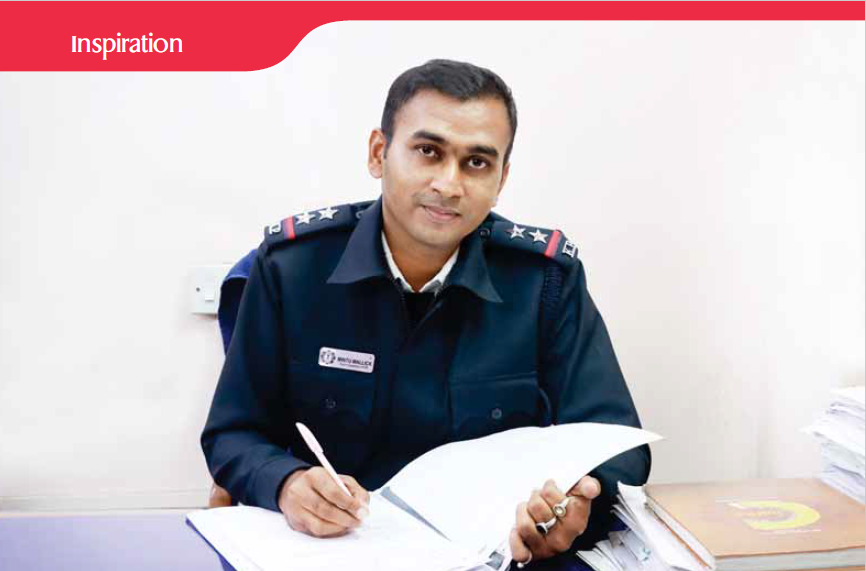
From Dreams to Duty: Dr. Mintu Mallick’s Inspiring Journey in Policing
By Ranabir Bhattacharyya
Policing demands a delicate balance of discipline, ethics, and an unwavering sense of professionalism. It transcends mere employment or a means of making a living. It is a calling that resonates deeply with many young Indians who aspire to serve their nation with pride and integrity. Dr. Mintu Mallick, the newly-appointed
Sub Inspector at Beliaghata Police Station, embodies this spirit of dedication. He represents the archetype of an individual driven by passion and patriotism, choosing the khaki uniform over a conventional academic career.
At 34 years old, Dr. Mallick’s journey is remarkable. Hailing from the Bagda area in North 24 Parganas, he has become a local sensation, inspiring many with his decision to pursue a life of service. The Kolkata Police, known for its esteemed legacy and deep-rooted connection with the community, undoubtedly attracts the crème de la crème of talent, making his achievement more impressive.
Dr. Mallick’s educational background is as impressive as his aspirations. He completed his early education in his native village, where he laid the groundwork for a promising academic journey. Excelling in his studies, he graduated with flying colours in Physics from Chakdah College, a testament to his intellectual prowess. He then advanced to Jadavpur University to pursue a Master’s degree, further solidifying his academic standing.
In 2016, he embarked on a rigorous journey towards his PhD, dedicating himself to research and scholarship, which he successfully completed in 2023. Alongside his doctoral studies, he earned a Bachelor of Education in 2015 and a Master’s in Chemistry in 2020. This year, he is set to complete his third Master’s degree, specialising in Education at Kalyani University. His academic achievements show his lifelong dedication to learning and excellence, a habit he developed early in life.
His story is not just about personal achievement; it is a narrative of passion, perseverance, and a profound commitment to serving his community. As he dons the uniform of the Kolkata Police, he stands ready to make a difference and inspire others to pursue their dreams of serving the nation.
The area of research for his doctoral studies invites a compelling examination due to its innovative approach and practical applications. He has dedicated significant effort to developing a graphene oxide-based ethylene gas sensor to monitor fruit freshness. Ethylene, the smallest plant hormone, plays an essential role in various developmental processes within plants. It influences critical stages such as the ripening of fruits, the promotion of seed germination, flowering, and even the ageing of leaves and flowers.
Ethylene concentration within the plant is a key indicator for determining the optimal time for harvest. Furthermore, monitoring ethylene levels in the atmosphere, particularly in storage facilities and during transportation is crucial for preventing the over-ripening of fruits. His pioneering research aims to create a multilayer graphene oxide-based ethylene gas sensor capable of accurately detecting ambient ethylene concentrations. This innovative sensor will be seamlessly integrated with commercially available Radio Frequency Identification (RFID) tags. Such integration allows for wireless monitoring, providing real-time insights into the condition of fruits and ensuring their quality throughout the supply chain.
Dr. Mintu Mallick proudly shares his journey, reflecting on his father’s commendable service in the Central Reserve Police Force (CRPF) for over 25 years. Inspired by his father’s dedication, he nurtured a lifelong aspiration to become a police officer – a dream that was not easily attainable due to fierce competition in what is regarded as one of the most revered professions in society.
To achieve his goal, he dedicated himself to intense preparation for the rigorous written examinations, ultimately applying for positions as a Sub Inspector and Wireless Supervisor. “This achievement feels like a dream come true,” he states, his eyes shining with enthusiasm. He expresses immense gratitude for the support he has received from his Officer-In-Charge and colleagues, labelling his experience thus far as extraordinary.
His proud parents have been a source of unwavering encouragement through his journey. He reminisces about his time spent in a hostel in Kolkata while studying at Jadavpur University—an experience that shaped him and now provides context to his current posting. With each passing day, he recognises the vast possibilities policing offers to serve the community and contribute positively to society. “It has undoubtedly been the best decision of my life,” he declares with conviction.
In addition to his policing career, Dr. Mintu Mallick is known for his approachable and friendly demeanour, quickly endearing himself to his peers. With roots in the theatre world – thanks to his association with Sutanuti Rongmukh – he blends a rich cultural background with his professional life. His colleagues and friends hold high hopes that he will continue to shine brightly in his role, ultimately becoming an asset to the Kolkata Police Force.

Robotic Surgery: The Future of Gynaecology and Gynaecologic Oncology
Dr. Rupashree Dasgupta is a Senior Consultant Robotic and Laparoscopic Gynaecologist and Gynae Onco Surgeon at Apollo Multispecialty Hospitals, Kolkata.
Background
Robotic surgery represents a remarkable convergence of technology and medicine, and much of its groundbreaking development can be traced back to the innovative efforts of the National Aeronautics and Space Administration (NASA). Initially conceived in the 1970s, the integration of robotic systems into surgical practices began as a military initiative, sanctioned by NASA and financed by the Defense Advanced Research Projects Agency (DARPA). The primary aim was to create a system that could operate in the absence of a surgeon, ensuring that astronauts in space and soldiers in combat zones received critical medical care even when direct human intervention was not possible.
Canada witnessed the dawn of robotic surgery in 1983 when an orthopaedic surgeon and a dedicated team executed the first successful robotic-assisted surgical procedure. However, the roots of this technology stretch even further back to 1958, when Dr. John Kwoh and his team were part of an important milestone in the development of robotic surgery when they utilised a robotic arm to perform a brain biopsy, guided by computed tomography (CT). This pioneering effort laid the groundwork for subsequent advancements in robotic surgical technology.
This was an early example of robotics in medicine, laying the foundation for further innovations in the field. Using a robotic arm for medical procedures was a pioneering effort at that time, long before the more well-known milestones in robotic surgery such as the first successful robotic-assisted surgery in 1983.
This early work by Dr. Kwoh and his team is an important part of the history of medical robotics. It helped pave the way for modern advancements in surgical technology, including precision in surgeries, minimally invasive procedures, and the development of robotic systems used widely in surgery today.
Dr. John Kwoh is recognised for his pioneering work in several notable robotic systems that emerged as the field evolved, each contributing unique capabilities to surgical practice. PROBOT marked a significant milestone as the first surgical robot designed specifically for prostate operations. Following closely was ROBODOC, which facilitated hip replacement surgeries with unparalleled precision. The ZEUS Robotic Surgical System (ZRSS) further enhanced the landscape of robotic surgery, paving the way for the widely recognised
Da Vinci Surgical System, which has since revolutionised many surgical procedures with its advanced dexterity and control.
The robots currently used in surgical procedures are configured in a master-slave arrangement, where the surgeon acts as the master, skillfully controlling robotic arms—the slaves—that are engineered with multiple degrees of freedom. A pivotal moment
in this technological journey occurred when the ZRSS successfully conducted the first robotic gynaecological surgery in Cleveland, Ohio, focusing on reconnecting fallopian tubes. This marked a significant step in robotic-assisted surgeries, which advanced further in 2009 with the introduction of the Da Vinci Surgical System in Israel.
In recent years, the adoption of robotic-assisted keyhole surgery in gynaecology has flourished, driven by remarkable technical advancements. Among these innovations, 3D visualisation stands out, offering enhanced depth perception, which is vital for distinguishing delicate anatomical structures. The technology also minimises hand tremors, providing surgeons unparalleled level of precision and the ability to delicately single out tissues. These enhancements contribute not only to a shorter learning curve for surgeons, making it easier for them to adapt to new methods, but also significantly boost their comfort during procedures compared to traditional keyhole and open abdominal surgeries.
When comparing robotic-assisted keyhole surgery to conventional approaches, the advantages are clear: surgical performance improves without extending operating time. This modern technique also results in minimal blood loss and reduces the incidence of intra or post-operative complications, all while decreasing the likelihood of necessary conversions to more invasive abdominal surgeries. Additionally, surgeons using robotic assistance report experiencing fewer musculoskeletal issues both in the short and long term, showcasing an important ergonomic benefit. Thus, surgeons equipped with robotic technology are more capable and achieve superior surgical outcomes for their patients.

Applications in Gynaecology and Gynaecologic Oncology
Robotic-assisted surgeries can be used for almost any procedure that is done with traditional methods like open surgery or laparoscopic surgery. This flexibility leads to better results for patients and makes surgery easier for doctors, showing how robotics is changing the field of gynaecology and gynaecologic cancer treatment.
Highlights
Surgeon-Controlled Robotic Arms (Master-Slave System) – In the innovative realm of robotic surgery, the surgeon acts as the master, skillfully manipulating specialised controls that translate their precise hand movements into electrical signals. These signals guide the robotic instruments with remarkable accuracy, allowing for intricate surgical procedures.
3D High-Definition Vision – Surgeons benefit from an enhanced three-dimensional view through a mere 8mm incision, providing incredible depth perception and allowing them to visualise anatomical structures with unparalleled clarity.
Endowrist Instrumentation – The robotic systems feature advanced Endowrist instruments that mimic the range of motion and dexterity of the human wrist, enabling surgeons to perform delicate manoeuvres that would otherwise be challenging or impossible.
Intuitive Motion and Surgical Dexterity – With intuitive motion capabilities, surgeons can operate seamlessly, maintaining full control while benefiting from motion scaling that filters out unintended tremors, ensuring a steady hand during complex procedures.
Reliable Replication of Surgical Standards – This cutting-edge technology guarantees consistent delivery of high-standard surgical outcomes, ensuring that patients receive the best care possible every time.
Advantages for Surgeons
Immersive Viewing – Surgeons can utilise a high-definition, three-dimensional view through 8mm incisions, giving them a comprehensive view of the surgical field.
Depth Perception and Magnification – With 10x magnification, intricate details are easily discernible, facilitating precision.
Camera Control – The surgeon retains command over the camera, allowing for dynamic adjustments during the procedure.
Enhanced Access – The system overcomes the natural limitations of human wrist movement, enabling access to previously unreachable areas easily.
Confined Spaces – Surgeons can operate effectively within limited spaces, expanding their capabilities.
Minimised Disease Transmission Risk – The robotic system reduces the likelihood of infection, providing a safer environment for surgeons and patients.
Advantages for Patients
Minimally Invasive Approach – The use of an 8mm incision results in reduced pain and discomfort.
Less Trauma – Patients experience diminished physical trauma compared to traditional surgery.
Reduced Blood Loss – The precise movements and techniques involved lead to less bleeding during and after the procedure.
Accelerated Recovery – Patients benefit from faster healing times, enabling them to return to their daily activities sooner.
Shortened Hospital Stay – With less invasive procedures, patients typically enjoy a decreased duration of hospitalisation.
Lower Medication Requirements – The reduction in pain and trauma translates to a decreased need for post-operative medications.
Applications in Gynaecology and Gynaecologic Oncology
Robotic Endometriosis Resection – This procedure involves the meticulous removal of abnormal cysts (chocolate cysts) and growths from the pelvic region while preserving the uterus and surrounding organs.
Robotic-Assisted Hysterectomy – Ideal for complex cases, such as those involving obese patients or individuals with a history of multiple surgeries, this technique simplifies the removal of the uterus.
Robotic Myomectomy – This procedure focuses on the removal of uterine fibroids while leaving the uterus intact, promoting future reproductive options.
Robotic Sacrocolpopexy – This procedure addresses uterine prolapse, using innovative techniques to restore anatomical support.
Robotic Interventions in Gynaecological Cancers – The platform enables effective treatment of endometrial and cervical cancers through small incisions, minimising the need for larger abdominal cuts.
Conclusion
Using computer technology in the operating room is a major step forward in surgery. By adding robotic systems, we can reduce or even eliminate the need for traditional open and laparoscopic surgeries, along with their limitations. This progress helps improve precision, safety, and overall results in surgical care.
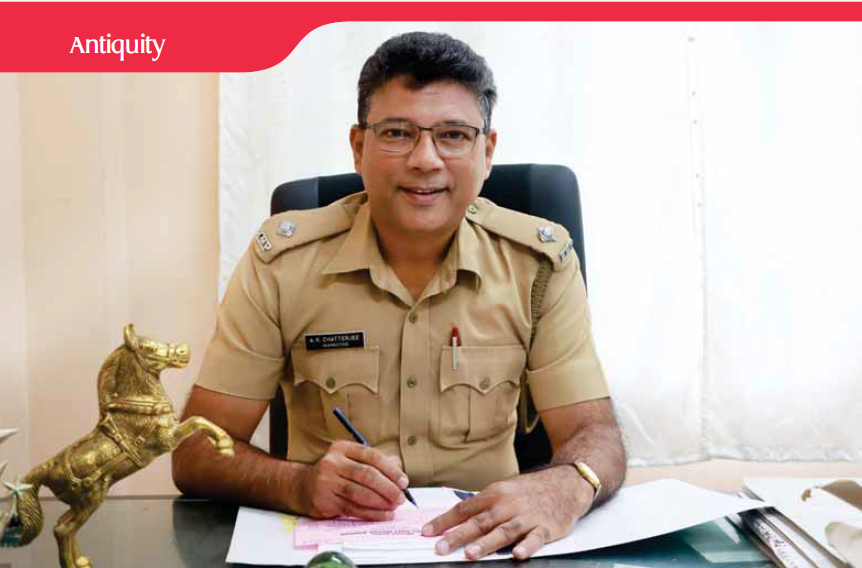
Saluting India’s Oldest Guardians of Heritage The Kolkata Mounted Police Force
A strong police force is grounded in courage, fitness, discipline, and resilience – qualities that ensure public safety and order. Among India’s many distinguished law enforcement units, the Kolkata Mounted Police stands out as the oldest, with a legacy of tradition and service.
Rather than being a relic of the past, the Kolkata Mounted Police remains vital to modern civic life. Whether managing crowds at Eden Gardens, maintaining order at Maidan football matches, or adding grandeur to the Republic Day parade, this unit exemplifies unwavering dedication to duty. The Kolkata Mounted Police is a force and a living symbol of discipline and heritage, blending history with contemporary relevance.
A Brief History
In the 1840s, during the British Raj, the Kolkata Mounted Police (then the Calcutta Mounted Police) was established with humble beginnings, starting with just two sowars (horse soldiers) under a Dafadar (Sergeant). Its primary role was to courier messages and notify the harbour master of incoming ships.
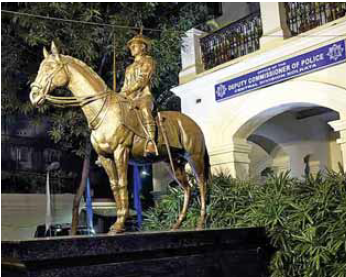
By 1857, the Calcutta Mounted Police had grown considerably and was recognised as one of the world’s top three mounted police forces, alongside those in London and Montreal. Under the leadership of a Superintendent of Police, the unit expanded its duties throughout the 19th century, including night patrols, traffic regulation, crowd management, ceremonial processions, and guards of honour.
The year 1912 marked a transformative period for the Mounted Police Department. Visionaries like Sir Charles Tegart, Sir Frederick Holliday, and John Eastwood introduced a structured schedule of duties, further professionalising the force. Riot and crowd control, became their primary focus, particularly at playgrounds and public events.
Initially, the Mounted Police was an exclusive domain for Europeans, with Indians restricted to lower ranks. Over time, this changed, allowing the force to evolve into a more inclusive unit. Today, the Kolkata Mounted Police is a product of its colonial past and a proud symbol of modern law enforcement.
The Calcutta Mounted Police inspired the creation of mounted units across India, with forces established in Gujarat, Kerala, Karnataka, Maharashtra, Hyderabad, and Chennai, all drawing from its legacy.
In 1948, the Lt. Governor’s Mounted Guard was merged with the Calcutta Mounted Police. The Force underwent further transformation, becoming a fully Indian unit that maintains its traditions while adapting to contemporary needs.
Renamed the Kolkata Mounted Police in 2001, the unit continues to honour its heritage, blending historical significance with modern relevance, and remains a symbol of discipline, tradition, and service in the heart of the city.

The Horse Saga
The horses of the Kolkata Mounted Police are the bloodline of the unit, embodying strength, and grace. Carefully selected from farms or received as gifts, they undergo rigorous training to meet the demands of service.
Traditionally, experienced officers and sowars handle the training, ensuring each horse is prepared for its diverse duties with precision and discipline. Before 2006, the Royal Calcutta Turf Club (RCTC) grounds served as the training facility. That year, the Kolkata Mounted Police established its own paddock at Maidan, providing a dedicated space for riding and workouts.
Training durations for the horses vary, with no fixed tenure. Horses transitioning from race tracks to police duties, for example, require specialised preparation, which can take a year or more, depending on the horse’s temperament and adaptability.
In recent years, the Kolkata Mounted Police has embraced modern techniques in horse rearing and training to enhance the effectiveness and well-being of the unit. A key part of this effort is the regular breeding programme at the Body Guard Lines Stable, where three to four horses are bred at intervals to ensure a strong force.
This steadfast commitment to horse rearing and training preserves tradition while allowing the Kolkata Mounted Police to remain a symbol of discipline and heritage.
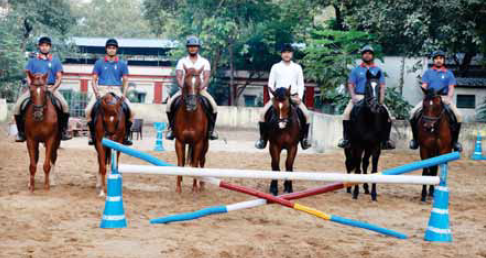
The horses receive regular health check-ups and high-quality veterinary care, with routine visits from a dedicated vet officer. Sowars and Syces (Groomers or Stable Attendants) provide first aid support when needed. The Force maintains an air-conditioned intensive care unit for critically-ill horses, equipped with advanced facilities such as ultrasonography, therapy, and minor surgery under general anaesthesia, all managed by specialised veterinary teams.
Workload Management
The Kolkata Mounted Police is unique as it is possibly the only mounted unit in India with its own manual, which was compiled in 1994. This detailed guide covers horsemanship techniques, remount training, crowd control tactics, recruitment procedures, and the responsibilities of each rank. The unit’s skilled officers and sowars train the horses using traditional and modern methods, including rehabilitating racehorses for police service.

Each day, the Kolkata Mounted Police begins its routine patrol of the Maidan area at 6 a.m. and wraps up around 8:30 a.m. Afternoon patrols occur at 2:30 p.m. in winter and 3 p.m. in summer, maintaining security and preventing misconduct in the area.
The daily routine is carefully structured, with sessions for exercise, training, grooming, and feeding. Each horse is fed three to four meals daily and consumes about 30 litres of water, depending on the weather. Regular exercise includes trotting, cantering, and jumping, while specialised training prepares the horses for navigating diverse terrain and managing crowd control with precision and care.
This disciplined routine ensures the fitness and readiness of the horses, reinforcing the Kolkata Mounted Police’s legacy as a model of excellence and commitment.
Currently, the Force has 63 horses. Seven are deemed unfit for exercise or patrolling due to age or medical conditions. These horses are evaluated by a board of veterinary officers and approved by the Police Commissioner of Kolkata. The Force consists of approximately 175 personnel, including inspectors, a veterinary officer, sowars, syces, stablemen, constables, civic volunteers, and sweepers, all working cohesively to maintain the unit’s operations.
As part of the protocol, when the President or Vice President of India visits Kolkata and stays at the Raj Bhawan, four horses and their sowars are stationed at the entrance for ceremonial duties, including a Guard of Honour.
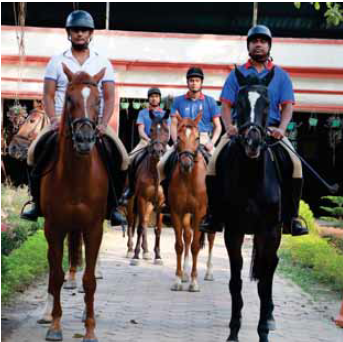
The Maidan area, the heartbeat of Kolkata, the City of Joy, is home to nearly 21 grounds. It serves as a vibrant hub for city activities. The Kolkata Mounted Police ensures law and order in this crucial zone and plays an essential role in preserving its greenery and safeguarding the city’s heritage and environment.
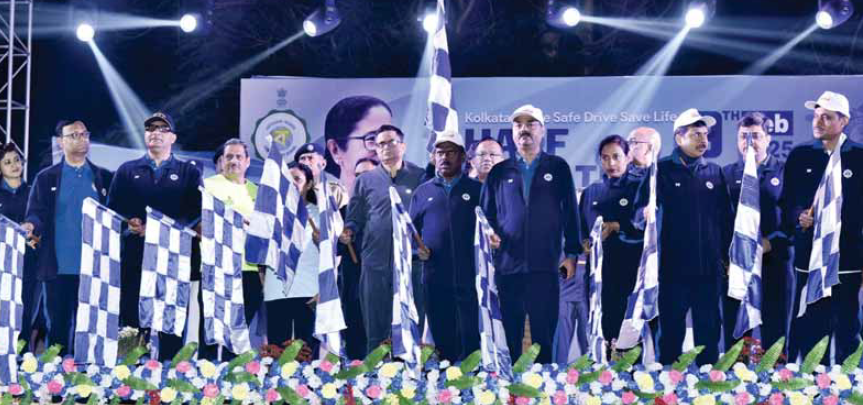
Safe Drive Save Life Half Marathon
The 5th Edition of the Kolkata Police Safe Drive Save Life Half Marathon was held successfully on February 9, 2025. The marathon had three categories: 21K, 10K, and 5K. The Half Marathon was flagged off by DG & IGP, West Bengal Rajeev Kumar. The Minister of Transport, Snehashis Chakraborty, and Secretary of the Transport Department, Saumitra Mohan, presided over the closing ceremony. Dignitaries and celebrities from different walks of life were present at the event to motivate and inspire the participants.

The Commissioner of Kolkata Police, Manoj Verma, a fitness enthusiast himself, completed the 21 KM run .
Incidentally, the Safe Drive Save Life campaign was launched by the Hon’ble Chief Minister Mamata Banerjee on July 8, 2016, to promote road safety and ensure that people can move across the city safely.
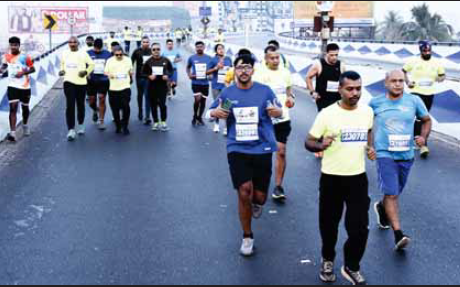
The first edition of the Kolkata Police Safe Drive Save Life Half Marathon was held in January 2018. Within two years, the Marathon has gained national prominence and is the biggest half-marathon event in the State.

All the runners received T-shirts, medals and certificates. The routes were chosen to reach out to all important neighbourhoods and to as many residents in the city as possible.
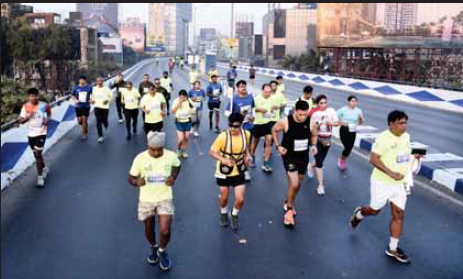
Sprinters and runners, irrespective of age group, gender, ethnicity and profession, participated in this grand occasion and joined hands to run for a safer road trip in future.
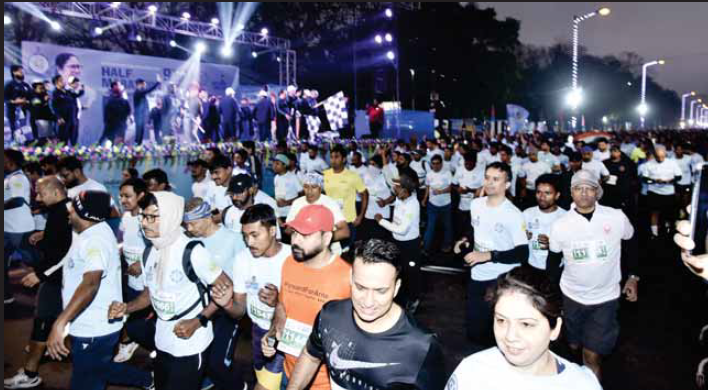
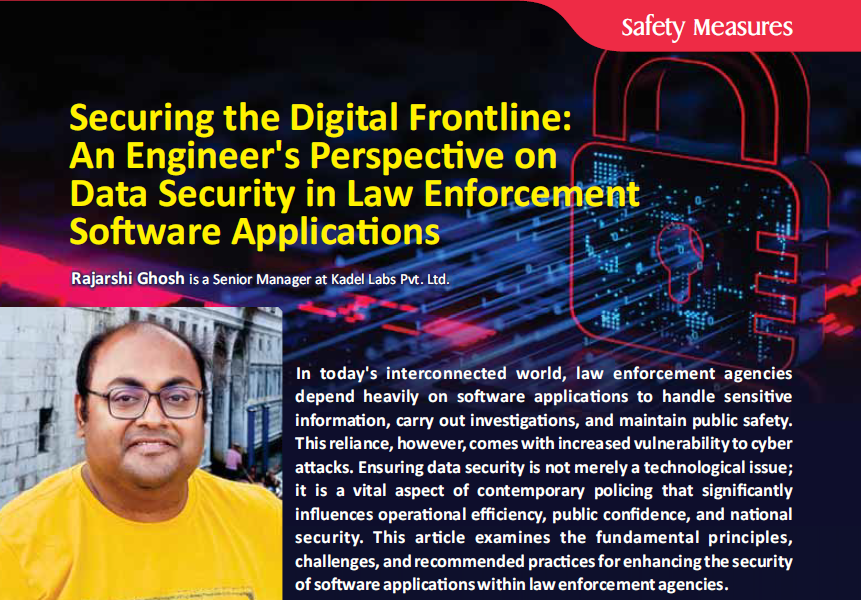
Securing the Digital Frontline: An Engineer’s Perspective on Data Security in Law Enforcement Software Applications

Rajarshi Ghosh is a Senior Manager at Kadel Labs Pvt. Ltd.
In today’s interconnected world, law enforcement agencies depend heavily on software applications to handle sensitive information, carry out investigations, and maintain public safety. This reliance, however, comes with increased vulnerability to cyber attacks. Ensuring data security is not merely a technological issue; it is a vital aspect of contemporary policing that significantly influences operational efficiency, public confidence, and national security. This article examines the fundamental principles, challenges, and recommended practices for enhancing the security of software applications within law enforcement agencies.
Importance of Data Security in Law Enforcement
Police organisations manage a wealth of sensitive information, including:
● Personal Identifiable Information (PII): Details about citizens, suspects, and officers.
● Case Files: Evidence, witness statements, and legal documents.
● Operational Data: Tactical plans, surveillance feeds, and patrol schedules.
● Criminal Records: Databases of past offenders and ongoing investigations.
There can be devastating consequences if this data is compromised. It will jeopardise investigations and expose officers to personal risks. Moreover, breaches erode public trust in law enforcement’s ability to protect the communities they serve.
In addition, as technology advances, the volume of data collected and stored by law enforcement agencies continues to grow. This includes video surveillance, body-worn camera footage, and digital evidence retrieved from mobile devices and computers. Protecting this vast amount of information requires a robust system and a proactive approach to emerging threats.
Key Threats to Software Applications
1. Ransomware Attacks: Cybercriminals encrypt critical data and demand payment for its release, disrupting operations and potentially halting critical services.
2. Data Breaches: Unauthorised access to sensitive information by hackers or insiders can result in leaked intelligence, compromised investigations, and legal liabilities.
3. Phishing and Social Engineering: Exploiting human vulnerabilities through deceptive emails, messages, or calls to gain access, to systems or sensitive data.
4. Zero-Day Exploits: Attacks on previously unknown vulnerabilities in software which can go undetected for extended periods.
5. Insider Threats: Malicious or negligent actions by authorised personnel who misuse their access to sensitive information.
6. Supply Chain Vulnerabilities: Risks introduced through third-party software, hardware, or service providers that may not adhere to strict security protocols.
7. Distributed Denial of Service (DDoS) Attacks: Overwhelming systems with traffic to disrupt services and hinder critical operations.
Principles of Data Security
To address potential threats, law enforcement agencies should follow these key principles:
1. Confidentiality
It is essential to ensure that sensitive information is accessible only to authorised personnel. Techniques to achieve this include:
Encryption: Protect data both at rest and in transit to prevent unauthorised access.
Multi-Factor Authentication (MFA): Implement access control measures that verify user identities through multiple methods.
Role-Based Access Control (RBAC): Restrict access based on individual job responsibilities.
2. Integrity
Safeguard data against unauthorised modifications to maintain its accuracy and reliability. Measures to ensure data integrity include:
Digital Signatures: Utilise these to verify the authenticity of data and prevent tampering.
Regular Integrity Checks: Use hashing algorithms to identify any discrepancies in the data.
Strong Version Control Systems: Maintain accurate records of changes for improved auditability.
3. Availability
Ensure that systems and data are accessible when needed. Strategies to enhance availability include:
Redundant Systems and Failover Mechanisms: Implement these to minimise downtime.
Regular Backups and Disaster Recovery Drills: Conduct these regularly to prepare for potential disruptions.
Load Balancers and Cloud-Based Solutions: Use these to manage increased demand and maintain service continuity.
4. Accountability
Monitor log user activities to detect and investigate possible misuse. This can be achieved through:
Audit Trails and Logs: Track access and changes to sensitive information.
Real-Time Monitoring and Alerts: Set up alerts for suspicious activities, such as unauthorised access attempts.
Well-Defined Policies: Establish clear guidelines for data handling and usage, along with consistent enforcement.
Guidelines for Securing Software Applications
1. Adopt a Zero-Trust Architecture
● Verify every user and device attempting to access the network, regardless of their location.
● Limit access to the minimum necessary for job functions and enforce segmentation to isolate critical systems.
2. Implement Robust Authentication Mechanisms
● Require MFA for all users, combining something they know (password), something they have (security token), and something they are (biometrics).
● Use biometric authentication, such as fingerprint or facial recognition, for high-security areas.
● Regularly update authentication methods to stay ahead of evolving threats.
3. Regularly Update and Patch Software
● Apply security updates and patches as soon as they are available to address known vulnerabilities.
● Automate patch management to reduce manual oversight and ensure consistency.
● Maintain an inventory of software and hardware to track updates and identify unsupported systems.
4. Encrypt Data
● Use advanced encryption standards (AES-256) for all sensitive data to protect it from unauthorised access.
● Employ secure key management practices to prevent keys from being compromised.
● Implement end-to-end encryption for communication channels to ensure confidentiality.
5. Conduct Security Awareness Training
● Educate officers and staff about phishing, social engineering, and other cyber threats.
● Simulate attacks to test and reinforce awareness, helping users recognise and respond to suspicious activities.
● Foster a culture of vigilance where cybersecurity is seen as everyone’s responsibility.
6. Employ Advanced Threat Detection Tools
● Use AI-driven analytics to identify anomalies, potential threats, and patterns indicative of an attack.
● Deploy intrusion detection and prevention systems (IDPS) to monitor and block malicious activities.
● Leverage endpoint detection and response (EDR) solutions to protect devices and isolate compromised systems.
7. Perform Regular Security Audits
● Assess systems and processes for vulnerabilities through penetration testing and vulnerability scanning.
● Hire third-party experts for unbiased evaluations and recommendations.
● Address findings promptly to strengthen security postures and mitigate risks.
8. Segment Networks
● Separate sensitive data from less critical systems using network segmentation.
● Use firewalls, access controls, and virtual private networks (VPNs) to enforce segmentation.
● Monitor network traffic for unauthorised access or anomalies that may indicate a breach.
9. Collaborate with Industry Experts
● Partner with cybersecurity firms and government agencies to access threat intelligence and expertise.
● Participate in information-sharing initiatives to stay informed about emerging threats and best practices.
● Leverage public-private partnerships to enhance capabilities and resources.
10. Develop Incident Response Plans
● Establish clear protocols for identifying, containing, and recovering from security incidents.
● Conduct regular drills to test the effectiveness of response plans and improve coordination.
● Ensure that plans are updated to address new threats and lessons learned from previous incidents.
Regulatory Compliance and Standards
Law enforcement agencies must adhere to local and international regulations regarding data security. Key standards include:
CJIS Security Policy: This set of guidelines outlines the secure handling of criminal justice information, covering aspects such as encryption, authentication, and auditing requirements.
GDPR: For agencies that handle data pertaining to EU citizens, compliance with the General Data Protection Regulation is essential to ensure transparency, accountability, and data protection.
NIST Cybersecurity Framework: This comprehensive framework assists organisations in managing cybersecurity risks through a structured approach to identification, protection, detection, response, and recovery.
ISO/IEC 27001: This international standard for information security management systems provides a systematic approach to protecting sensitive data.
By adhering to these standards, agencies can meet legal requirements, implement industry best practices, and build public trust in their capability to safeguard information.

Emerging Technologies in Law Enforcement Security
1. Artificial Intelligence (AI)
AI-powered tools can predict and mitigate threats by analysing vast amounts of data in real time. Use cases include:
● Identifying phishing attempts and other malicious activities through behavioural analysis.
● Automating incident responses to reduce the time taken to address threats.
● Enhancing video analytics to detect suspicious behaviours or unauthorised access.
2. Blockchain
Unchangeable ledgers can enhance the integrity of evidence management systems by preventing tampering and ensuring transparency. Applications include:
● Secure chain-of-custody tracking for digital evidence.
● Decentralised identity management to strengthen authentication.
3. Quantum Cryptography
Although still emerging, quantum cryptography promises unparalleled encryption capabilities, protecting against future threats posed by quantum computing.
4. Biometric Security
Advanced biometric systems, such as facial and voice recognition, provide robust authentication mechanisms for sensitive applications. These systems can also support access control for secure facilities and devices.
5. Cloud Security
Cloud-based solutions offer scalability and advanced security features, such as real-time monitoring, automated backups, and enhanced encryption. Agencies must work with trusted providers to ensure compliance with regulations and maintain data sovereignty.
Building a Cyber-Resilient Culture
Technology alone cannot ensure comprehensive data security; it must be complemented by a robust culture of cybersecurity within agencies. This can be achieved through several pivotal strategies:
Leadership Commitment: Senior officials must not only prioritise cybersecurity but also lead by example, integrating it into essential budgets, thoughtful policies, and the daily operations of their teams. Their unwavering commitment sets the tone for the entire organisation.
Continuous Education: Providing ongoing training opportunities is crucial for keeping personnel informed and alert. Regular workshops, simulations, and updates on the latest threats will empower employees to recognise vulnerabilities and respond effectively to an ever-changing cyber landscape.
Proactive Planning: Formulating detailed response plans in advance prepares organisations for potential incidents. Conducting regular drills can simulate various scenarios, enabling teams to rehearse their responses, which ultimately reduces downtime and mitigates the severity of impacts when real threats arise.
Collaboration: Encouraging collaboration across departments and with external partners is vital in enhancing the agency’s overall security framework. By sharing insights, resources, and strategies, organisations can build a stronger, unified defense against cyber threats, creating a network of support and vigilance.

Conclusion
In today’s digital landscape, the security of software applications stands as a critical priority for law enforcement agencies. As technology continues to evolve, so do the threats that accompany it, underscoring the importance of a thorough understanding of these risks. By adhering to essential principles and embracing best practices, agencies can effectively bolster their operations while fostering trust within the communities they serve. Data security transcends mere technical compliance; it is an essential pillar of effective policing in the 21st century. This ongoing commitment to safeguarding sensitive information is vital for maintaining public confidence in law enforcement. By making continuous investments in cutting-edge technology, comprehensive training, and robust collaboration with various stakeholders, law enforcement agencies can stay one step ahead of cybercriminals, ensuring the safety and security of our communities in an increasingly interconnected world.
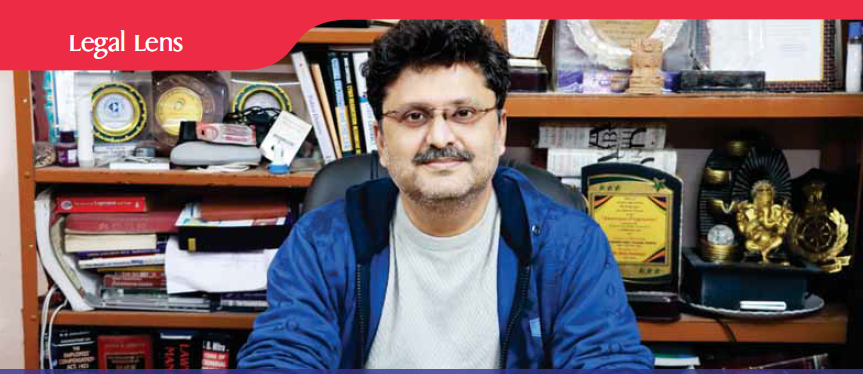
The Growing Threat of Digital Arrest and Its Impact on Society
Bivas Chatterjee is a Special Public Prosecutor, Cyber & Electronic Evidence, Govt of West Bengal.
In today’s world, particularly in India, one of the most common forms of cybercrime is digital arrest. In this clever scam, scammers imitate law enforcement personnel to extract enormous sums of hard-earned money from unsuspecting middle-class residents. This crime has grown to terrifying proportions, frequently involving well-coordinated, cross-border criminal networks that operate with meticulous planning and sophisticated technology.
Such fraudulent actions are more than just individual scams; they pose a significant economic hazard, draining resources from victims and damaging financial stability. In essence, digital arrest is a sort of economic terrorism, waging an economic war against the country.
Modus Operandi
Initially, scammers call a potential victim and scare them with arrest or harsh repercussions while pretending to be police officials. They utilise a variety of strategies to persuade the victim that they are involved in a criminal case. To capture the victim’s faith, scammers transmit fake and fraudulent documents pretending to be issued by various police departments. They even force the victim to engage in a video call while they pretend to be police officers, wearing a police uniform.
Several cases of digital arrest have been reported across the country, highlighting the urgent need for awareness and preventive measures. Here are some notable instances:
(A) Bangalore Victim Held Under Digital Arrest
The North East Division Cybercrime Police have registered a case where fraudsters, posing as officials from the Telecom Regulatory Authority of India (TRAI), manipulated and extorted a victim by falsely implicating him in financial crimes.
The scammers threatened the victim with prosecution under the Prevention of Money Laundering Act, 2002, claiming that his bank accounts were under investigation. Under constant intimidation, he was virtually held hostage for nearly a month while they accessed his bank accounts and transferred large sums of money.
To make the deception more convincing, the criminals falsely accused him that his SIM card is linked to fraudulent activities, with an alleged case registered by the Mumbai Police. They also accused him that his Aadhaar card is being misused to open a bank account involved in money laundering. Fearful of legal consequences, the victim complied with their demands, resulting in significant financial loss.
(B) Japanese Man Falls Victim to Digital Arrest
In another worrisome case, a Japanese national working in Bengaluru was robbed of ₹35.5 Lakhs by cybercriminals acting as Mumbai Police officers. The scammers falsely accused him of involvement in a money laundering case. They intimidated and tricked him to extract a huge payment. The victim first received a call from someone impersonating a Telecom Regulatory Authority of India (TRAI) official. The scammers digitally arrested and coerced him into transferring ₹35.5 Lakhs under false pretences of clearing his identity from fictitious accusations.
(C) Karnataka Government Employee Defrauded of ₹19 Lakhs
A Karnataka State Government employee was digitally arrested for six hours by someone impersonating himself as a Mumbai Crime Branch officer. The fraudster said that the victim’s SIM card was being used for criminal activities and subjected him to severe harassment, ultimately swindling
₹19 Lakhs from him. The victim was detained in a video conference for six hours while the fraudster conducted a fake online investigation, during which he obtained important financial information. The victim lost his hard-earned money as a result of the incident.
(D) Elderly Woman Duped of ₹5.66 Crores
In a shocking case, a 69-year-old woman lost a staggering ₹5.66 Crores after being digitally arrested for nearly 20 days in a Skype call. Following a pattern similar to other scams, the fraudsters falsely claimed that her mobile number, linked to her Aadhaar, was connected to a money laundering case. Under the pretence of verifying her financial status, they convinced her into transferring all her funds, falsely assuring her that the money would be refunded after verification.
Digital Arrest Case in West Bengal
A disturbing case of digital arrest fraud was recently reported in West Bengal, where a victim was coerced into transferring ₹1 Core under false pretenses.
The victim received a WhatsApp call from someone pretending to be a Sub-Inspector of the Mumbai Police. The fraudster falsely claimed that the victim’s name had been associated with a financial fraud case due to insolvency concerns. To make the hoax appear real, the scammer provided fake legal documents with the victim’s name incorrectly recorded as an accused party.
The caller intimidated the victim and his wife, threatening to arrest them if he did not comply. Under intense psychological pressure, the fraudster prevented the victim from stopping the call, thus placing him under digital arrest. The victim was forced to deposit ₹1 Crore into numerous accounts, which he provided with IFSC data over WhatsApp chat. The conversation recordings clearly reveal the scammer’s urgent instructions to transfer the funds right away.
Investigation and Evidence Collected
The investigation into this digital arrest scam has revealed a highly organised financial fraud network. Authorities have gathered crucial evidence, leading to significant breakthroughs in the case.
The bank statements containing the debit details have been seized from the complainant, and the authenticated bank account statement, which includes fraudulent debit transactions, provides clear evidence of the crime.
The authenticated Bank AOF (Account Opening Form), KYC (Know Your Customer), and statements from all first-layer beneficiaries have been collected. These documents provide crucial evidence that the amounts were credited to the fraudulent accounts and subsequently utilised via instant transfers.
The fraudulent accounts were opened using forged documents by the accused and their associates, allowing for immediate transfers of funds to other accounts. This indicates that the caller, the account holders, and others are all part of a criminal conspiracy and are liable for the crime.
The account in question is registered in the name of one of the fraudsters, and the transactions are clearly reflected in the statement. Additionally, numerous NCRP (Non-Cognizable Report) complaints have been filed against this bank account.
The seized statement from the complainant, along with the authenticated statements collected from the bank, further confirm the fraudulent transactions. By analysing the various authenticated account opening forms, KYC documents, and bank statements, investigators have successfully cracked the criminal gang involved.
The person impersonating as a Sub Inspector of the Mumbai Police set a trap for the victim using the ‘Digital Arrest’ tactic. The impersonator shared the account details of a key criminal via WhatsApp to enable the deposit of the money.
CDR (Call Data Records) and other TSP (Telecom Service Provider) data were used to establish connections between various apprehended offenders. The phones used in the crime were taken from the accused’s possession. Furthermore, other bank accounts belonging to other individuals and businesses were recovered from their possession.
A bank employee who activated numerous important bank accounts related to the crime is also being investigated. The chief fraudster, who leads a team based in Cambodia, oversees a network of similar crooks participating in the commission of these digital crimes.
Seventeen people have been arrested thus far, and investigation is ongoing.
A Heartbreaking Impact
Perhaps the most heart-wrenching aspect of this case is that the victim’s wife is undergoing a cancer battle. They have now lost their entire life-savings to fraudsters. Left with no financial resources, they are now struggling to afford the expensive cancer treatment, making this crime not just a financial disaster but also a life-threatening nightmare for the victim’s family.

Global Nexus of Digital Arrest Crimes
Investigations into digital arrest scams have revealed a highly organised international cybercrime network. Strong evidence suggests that these crimes are being orchestrated from various parts of the world, making law enforcement efforts highly challenging.
A significant portion of these crimes is being operated from Cambodia, Hong Kong, and other foreign jurisdictions. Many of these countries lack mutual legal assistance (MLA) and extradition treaties with India, creating significant legal and investigative roadblocks. Lack of official cooperation agreements between India and foreign countries restricts the authority to trace, detain, and punish the primary criminals.
Investigators have had limited success in cracking down Indian-based facilitators, while the masterminds continue to operate from abroad with impunity. The fraud funds are transferred to Indian bank accounts, which are frequently opened using false paperwork. These funds are subsequently translated into digital currencies like cryptocurrency and transmitted to anonymous overseas wallets, making financial tracking nearly impossible.
Digital Arrest and Digital Slavery
During investigations into digital arrest and digital slavery, it was discovered that young people from India were lured to lucrative jobs in Cambodia and other parts of the world. However, upon arrival, their passports and other documents are seized, and they are forced to work in fraudulent call centres. These individuals are then coerced into committing crimes by impersonating law enforcement officers so they can then extort money from victims. The fraudsters send forged documents bearing the logos and stamps of various law enforcement agencies. They even wear police uniforms during video calls. The victims, upon seeing the official appearance of the perpetrators, are intimidated and manipulated, often divulging their financial details. As a result, their hard-earned money is siphoned off without their knowledge.
Challenges of Investigating Digital Arrest Crimes
Despite digital arrest being one of the most prevalent crimes in the virtual world today, investigations remain a significant challenge for law enforcement agencies across India. Some of the key hurdles include:
1) Cross-Border Investigation
A significant portion of these crimes is committed from countries outside of India, leading to challenges typically faced in trans-border crime investigations. The international nature of these offences complicates coordination and evidence collection, especially when perpetrators are based in regions where India has limited legal cooperation.
2) Dealing with Cryptocurrency
In many cases, large sums of money are converted from Indian Rupees to cryptocurrencies, facilitating more seamless international transactions for the fraudsters. Investigating the money trail becomes extremely difficult, as digital currencies are harder to trace. When Indian perpetrators are arrested, it is often discovered that they only receive a small fraction of the stolen funds. Indian agencies largely depend on international conversion portals to track the flow of money, but this method poses a major limitation in gathering concrete evidence.
3) False and Fraudulent KYC Verification
Thousands of fraudulent bank accounts are created, often with the assistance of corrupt bank officials who facilitate the movement of stolen funds. The core issue here is fake KYC verification which allows criminals to bypass regulatory checks. In one recent case in Bengal, investigators uncovered thousands of fake accounts created specifically to handle illicit transactions. These accounts serve as a layer upon layer of fraudulent channels, through which stolen money is funnelled to the fraudsters.
4) Lack of Awareness
A significant challenge is the lack of awareness among the public, particularly among senior citizens, who are often the primary targets of such scams. When victims are digitally detained, they often fear cooperating with law enforcement, worried they might be falsely accused or prosecuted. By the time victims realise they have been scammed, the crime has already been carried out, making it much harder to trace the evidence.
5) Training of Investigating Agencies
A critical need for law enforcement agencies is specialised training in digital crime investigations. Investigating officers must be equipped with the knowledge and skills to tackle this gruesome economic terrorism that is widespread across India. Without this expertise, the ability to effectively counter these crimes remains limited.
The Most Effective Remedy: Awareness
The simplest and most effective remedy is widespread awareness. It is crucial to inform the public, especially senior citizens, that digital arrest is part of a well-organised criminal network. Many victims are unaware of the severity of the crime until it is too late. Once the funds are siphoned off, often beyond India’s borders, it becomes nearly impossible to recover the stolen money. Raising awareness about this form of crime and its consequences is essential to protecting vulnerable individuals from falling victims to such scams.
Penal Law Provisions for Digital Arrest Cases According to Bharatiya Nyaya Sanhita (BNS), 2023
The following sections of the Penal Law should be invoked in subsequent cases related to digital arrest:
1. 319(2) BNS: Whoever cheats by personation shall be punished with imprisonment of either description for a term which may extend to five years, or with fine, or with both.
2. 318(4) BNS: Whoever cheats and thereby dishonestly induces the person deceived to deliver any property to any person, or to make, alter or destroy the whole or any part of a valuable security, or anything which is signed or sealed, and which is capable of being converted into a valuable security, shall be punished with imprisonment of either description for a term which may extend to seven years, and shall also be liable to fine.
3. 338 BNS: Whoever forges a document which purports to be a valuable security or a will, or an authority to adopt a son, or which purports to give authority to any person to make or transfer any valuable security, or to receive the principal, interest or dividends thereon, or to receive or deliver any money, movable property, or valuable security, or any document purporting to be an acquittance or receipt acknowledging the payment of money, or an acquittance or receipt for the delivery of any movable property or valuable security, shall be punished with imprisonment for life, or with imprisonment of either description for a term which may extend to ten years, and shall also be liable to fine.
4. 336(3) BNS: Whoever commits forgery, intending that the document or electronic record forged shall be used for the purpose of cheating, shall be punished with imprisonment of either description for a term which may extend to seven years, and shall also be liable to fine.
5. 61(2) BNS: Whoever is a party to a criminal conspiracy – (a) to commit an offence punishable with death, imprisonment for life or rigorous imprisonment for a term of two years or upwards, shall, where no express provision is made in this Sanhita, for the punishment of such a conspiracy, be punished in the same manner as if he had abetted such offence; (b) other than a criminal conspiracy to commit an offence punishable as aforesaid shall be punished with imprisonment of either description for a term not exceeding six months, or with fine or with both.
6. 351(2) BNS: Whoever commits the offence of criminal intimidation shall be punished with imprisonment of either description for a term which may extend to two years, or with fine, or with both.
7. 317(4) BNS: Whoever habitually receives or deals in property which he knows or has reason to believe to be stolen property, shall be punished with imprisonment for life, or with imprisonment of either description for a term which may extend to ten years, and shall also be liable to fine.
8. 66C ITAA (Information Technology (Amendment) Act, 2008: Whoever, fraudulently or dishonestly make use of the electronic signature, password or any other unique identification feature of any other person, shall be punished with imprisonment of either description for a term which may extend to three years and shall also be liable to fine which may extend to rupees one lakh.
9. 66D ITAA 2008: Whoever, by means of any communication device or computer resource cheats by personation, shall be punished with imprisonment of either description for a term which may extend to three years and shall also be liable to fine which may extend to one lakh rupees.
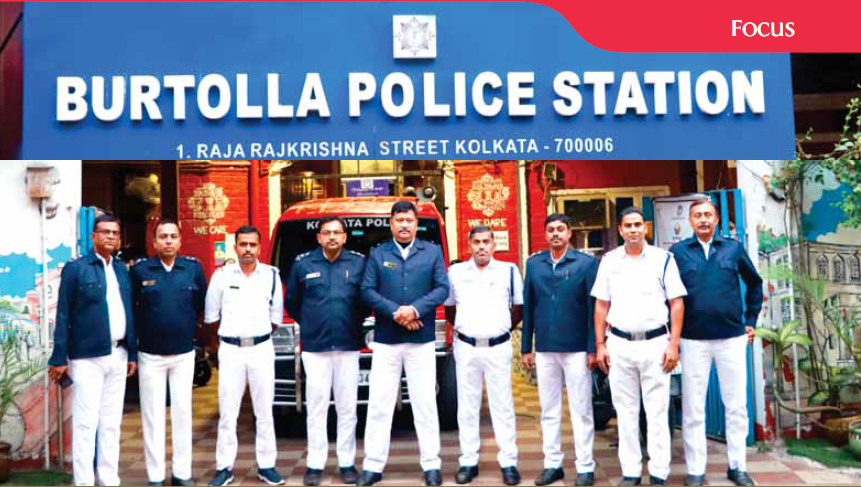
Burtolla Police Station: Legacy, Service and Strength
Ranabir Bhattacharyya, Team Protector.
Established in 1888, Burtolla Police Station stands as one of the oldest police stations in India, a sentinel of justice woven into the rich cultural tapestry of the North and North Suburban Division of the Kolkata Police Force. Nestled at 1, Raja Rajkrishna Street, this historic institution is more than just a law enforcement hub -it is a testament to the enduring values of duty, discipline, and dedication. With its red-bricked façade and towering watchtowers, remnants of the British era, Burtolla Police Station seamlessly bridges the past with the present, preserving tradition while embracing modern efficiency.
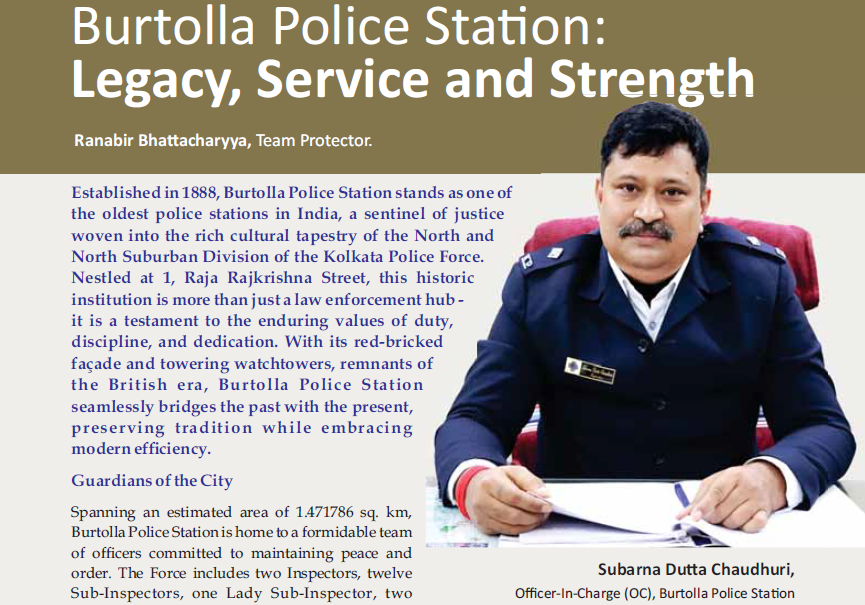
Guardians of the City
Spanning an estimated area of 1.471786 sq. km, Burtolla Police Station is home to a formidable team of officers committed to maintaining peace and order. The Force includes two Inspectors, twelve Sub-Inspectors, one Lady Sub-Inspector, two Sergeants, seventeen Assistant Sub-Inspectors, three Assistant Sub-Inspectors, forty-nine Constables, seven Lady Constables, thirteen Home Guards, thirty Civic Volunteers, and eighteen Lady Civic Volunteers – each playing a crucial role in ensuring the safety of the community.
Community Policing
At Burtolla Police Station, law enforcement goes beyond crime prevention. Various community outreach initiatives, such as Pronam (dedicated to senior citizens), regular health checkups, puja parikrama, and emergency medical assistance, have strengthened the bond between the police and the people. The Nabadisha Project, a Kolkata Police initiative aimed at uplifting underprivileged children, provides private tuition to around thirty students from Pre-Primary to Class V. Additionally, the Station recently hosted the 1187th Blood Donation Camp, an integral part of Utsarga, a flagship initiative of the Community Policing Wing of Kolkata Police, promoting voluntary blood donation, was held at the Burtolla Police Station ground.
The Man Behind the Badge: Subarna Dutta Chaudhuri
Officer-In-Charge (OC) Subarna Dutta Chaudhuri embodies the spirit of service and resilience. Reflecting on his journey, he shares, “This area is a living testament to North Kolkata’s heritage. The warmth of the people here is unmistakable. From bustling markets and metro stations to hospitals and educational institutions, Burtolla is a manifestation of Kolkata’s vibrant life.”
Speaking about his journey as a police officer, he shared, “I am the first in my family to join the police force. I completed my schooling at Julian Day, Ganganagar, and later pursued a degree in Zoology from Jaipuria College. Since childhood, I had dreamed of joining the Indian Army. Incidentally, my family runs a solicitor firm, and I also completed my LLB. Being an only child, I had one condition—I would stay in Kolkata with my parents. In 1996, my dream came true when I joined the Kolkata Police, marking the beginning of an incredible journey.”
Incidentally, Subarna Dutta Chaudhuri began his journey in uniform at Tangra Police Station before being transferred to Phoolbagan Police Station.
He then had a brief tenure at the State Vigilance Commission, followed by successive postings at Shakespeare Sarani and Bhawanipur Police Stations. As a Second Officer, he was assigned to Burtolla Police Station, where he served until 2014. After a three-month stint at Lake Police Station, he spent two and a half years at Kasba Police Station. As Officer-in-Charge, he led West Port, followed by postings at Tiljala and Ultadanga, before ultimately taking charge as the OC of this historic police station.
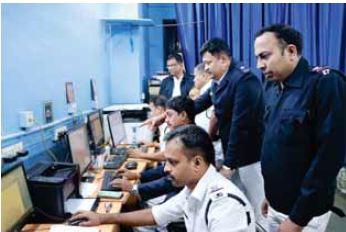
Trials, Triumphs and an Unwavering Resolve
“There are some incidents that remain etched in our memories. During my first stint at Burtolla Police Station, a robust man was found dead in a brothel in Sonagachi. One of our departmental colleagues was tasked with investigating the mysterious death. Three months later, the post-mortem report revealed that the man had died by manual strangulation. Interestingly, the deceased had a live-in partner, a thin and frail-looking woman, who was with him on that tragic day. Circumstantial evidence pointed to her as the possible suspect. However, concrete proof was necessary to present to the court. It is known that a person is most vulnerable during sexual intimacy. If someone is strangled during such an intimate moment, death can occur almost instantly.” This entire incident and the method of operation truly underscored the medico-legal expertise of the Officer in Charge (OC).
The highly publicised RG Kar incident caused significant stress for all of us involved. We faced strong criticism, but the most challenging aspect was the social ostracisation we endured, which was truly unimaginable. I live in Salt Lake, and whenever someone passes away in our community, I make sure that all necessary arrangements are handled appropriately. However, after this incident and the ensuing protests, our community became divided. It was an unpleasant experience that we did not deserve. During the COVID-19 pandemic, I faced physical segregation as a frontline worker. Yet this time, many of my acquaintances turned against me simply because I am a police representative. That was shocking, to say the least. My daughters, who were still in school and college, also went through a tumultuous time as they were not spared from the backlash. This was especially painful for me. I am very grateful for my school friends who stood by me through thick and thin. I can only say that as a member of a law enforcement agency, we must exercise patience during these times. We work tirelessly in accordance with the law, and I truly believe that truth will prevail. I also believe that, ultimately, time will heal everything,” remarked the veteran police officer.
An Officer with an Unyielding Spirit
Subarna Dutta Chaudhuri has been recognised with numerous awards throughout his distinguished career. With strong credentials in medico-legal matters, he has been instrumental in solving complex cases, earning widespread praise for his investigative breakthroughs. His academic foundation in Zoology, coupled with further studies in Physiology and human anatomy, has provided invaluable insights for the Department in critical investigations.
A marksman of exceptional calibre, he is regarded as one of the finest shooters in the police fraternity, having won three gold medals and four silver medals while representing the Kolkata Police. He was honoured with the Seva Padak in 2011 and the Bravery Award in 2021 for his dedication and service.
One of the most defining moments of his career was the West Port incident, where he sustained severe injuries in the line of duty. Recalling the harrowing experience, he shared:
“In 2021, a dacoity on the Garden Reach Flyover became a major concern for us. A gang had brutally assaulted a man and fled with ₹4 Lakhs. At West Port Police Station, we had a dedicated team determined to bring them to justice. We hunted them down and were able to identify the suspects. Two days after this incident, on June 29, as we were doing a thorough check on the same flyover, three individuals on three motorcycles attempted a similar tactic. We went in hot pursuit after them. At one point, I became separated from my team and managed to grab hold of one of the bikers. However, this suspect on a Royal Enfield accelerated, causing me to lose balance and crash onto the road, with blood pouring out from my wounds.
Despite my condition, I managed to note down the number plate details before reaching Garden Reach State General Hospital. Doctors confirmed a severe hand fracture, necessitating an emergency operation at a private hospital, where the Department ensured I received the best possible care.
It was the peak of the COVID-19 pandemic, and the private nursing home felt like something out of a horror story. However, within my capacity as a police officer, I extended help to the COVID patients around me. Since I was not a COVID patient, I was allowed to keep my mobile phone, and I used it to the best of my ability to assist others. I was finally discharged on July 7. That experience changed me forever.”
While Burtolla has long dealt with the challenges of its red-light district, the rise of cybercrime presents a new frontier of challenge to the police. The police station remains proactive, engaging with citizens, especially the elderly, through digital awareness programmes and WhatsApp groups. The Station’s recent swift action in the heinous case of a seven-month-old baby’s assault epitomises their relentless pursuit of justice.
Leaving a Legacy
As he nears his 30th year in service, Subarna Dutta Chaudhuri remains unwavering in his belief: “You can do all the good things in police uniform.” His journey is not just one of duty but of inspiration-proof that true leadership is defined by courage, compassion, and an unbreakable commitment to justice.
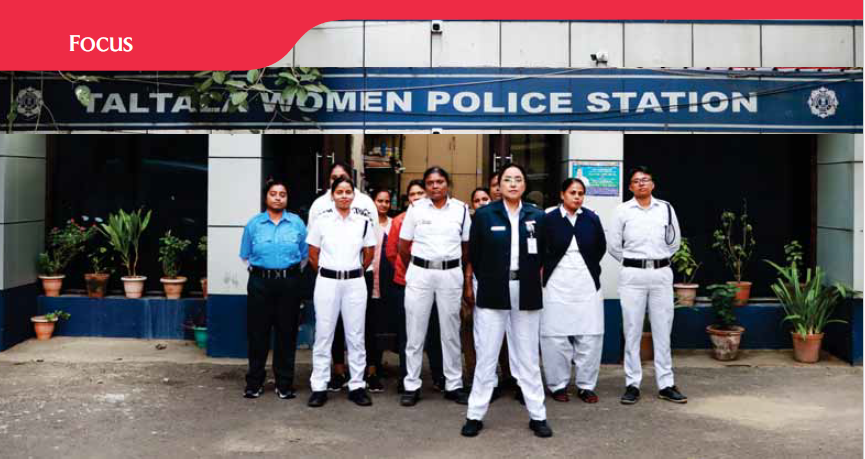
Taltala Women Police Station: Empowering Change 24×7
The Taltala Women Police Station is one of the most important police stations in the heart of Central Kolkata. It is responsible for nine police stations in the Central Division, which include Bowbazar, Burrabazar, Girish Park, Hare Street, Jorasanko, Muchipara, New Market, Taltala, and Posta. The Station was officially inaugurated on January 13, 2017, and it has a total strength of 27 personnel.
The Officer-in-Charge of the Station, Shrinkhala Sharma, emphasised the positive impact this police station has had in the community, saying, “This police station has made a positive difference locally. Previously, women would only visit the police station during the day to file complaints. Now, they find the station to be more accessible and welcoming. This transformation has helped build the confidence of women in our society. We handle a variety of complaints, ranging from domestic violence to cybercrime, and we strive to ensure that justice is served so that they can return home with a smile.”
Shrinkhala Sharma is a seasoned and decorated police officer who joined the Force in 2004. She was born and raised in Kalimpong. Shrinkhala completed her undergraduate studies at Loreto College in Darjeeling, followed by her postgraduate degree in Siliguri. She later earned a Bachelor of Education (BEd) from Darjeeling. “Initially, I prepared for jobs related to academia. However, after the sudden loss of my mother, my perspective on life changed significantly. I decided to follow in my sister’s footsteps – that as a woman in Khaki. This decision led to a life-changing journey, and I have now completed 20 years in uniform within one of the best police forces in the world.”
After completing her 15-month training, Shrinkhala Sharma joined the South Port Police Station in 2006. A year later, she transferred to the Park Street Police Station, and then to the Beniapukur Police Station, where she served for three years. After spending five years at the Karaya Police Station, she returned to the Park Street Police Station, this time being promoted to Officer-In-Charge of the Women Grievance Cell at Lalbazar Headquarters. Following a brief tenure as the Officer-In-Charge of the Ultadanga Women Police Station, she took on the role of Officer-In-Charge at the Taltala Women Police Station.
The Formative Years
“As I am from the hills, my Bengali was not very good. Thankfully, in the Port Division, I had no trouble communicating with the Hindi-speaking population. Looking back now, I feel extremely fortunate to have joined the police service and to serve society. Initially, I was very skeptical when my sister joined the police. My first visit to a police station was when she started her career. However, as I learned more about this profession—the opportunity to listen to people’s problems, address their complaints, and help them achieve justice—I became grateful for my role in the Kolkata Police Force,” says Shrinkhala, reflecting on her commitment to the job.
Experience Working in the Women Grievance Cell
“When I began my career at a general police station, the system and environment were quite different. Over the years, it has become more accessible. At the Lalbazar Women Grievance Cell, I had the opportunity to listen to the complaints of distressed women and families in urgent need of help.
I empathised with them and provided counseling. Whether it involved abuse, torture, trauma, or violence, these experiences profoundly changed me. I handled various cases, many of them critical, and assisted the victims and their families in pursuing justice through legal channels. Overall, this experience made me more efficient, resilient, and truly dutiful in my role,” remarked Shrinkhala Sharma.
Examining the complaints received at the Taltala Women Police Station, it is evident that the demographics are similar to those in Beniapukur, Karaya, and other areas of Central Kolkata. Most registered cases involve incidents of domestic violence, rape, and POCSO (Protection of Children from Sexual Offences). Women from underprivileged sections of society often approach the officials at Taltala Women Police Station in distress.
“In many instances, married women do not wish to take action against their husbands. Instead, they request us to talk to them, hoping to prevent further violence. However, these women frequently return the next morning with bruises and cuts. In such cases, we are obligated to intervene. Additionally, we receive complaints of rape, where women are given false promises of marriage that never materialise. POCSO cases involving minors are also prevalent. We are also increasingly receiving complaints regarding various forms of cybercrime affecting women,” added Shrinkhala Sharma.
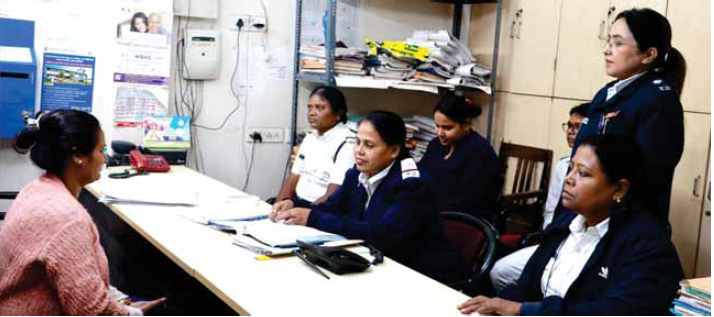
Fighting the Mental Health Clock
The mental health challenges faced by men and women in uniform are ever-present. “My biggest stress reliever is my daughter. Whenever I’m home, I fully immerse myself in my role as her mother. I teach her English and Social Studies. I recently lost my pet dog, which was difficult, but when I’m with my daughter, I focus entirely on her. This certainly helps reduce my stress. When I return to my uniform, I leave everything else behind. I dive deeply into each case and make sure that I read everything thoroughly. After all, no woman comes to the police station for a casual visit; something must have happened that has troubled or distressed her. Proper investigation is our priority, and we have a duty to seek justice for the women who reach out to us for help. In this respect, I must admit that wearing the uniform offers us a unique opportunity that no other job or profession can provide,” remarks OC Shrinkhala Sharma.
“In one particularly heartbreaking case under the jurisdiction of Karaya Police Station, I had the privilege of being part of a team that rescued a young girl who had been subjected to unimaginable abuse by her own father. Along with her, we also ensured the safety of her little sister, sparing her from the same brutality. Today, I am filled with immense relief and hope as I see the girl thriving in a respected organisation, while her sister prepares with determination for her Board exams.
This experience stands as a testament to what Kolkata Police is all about – being there for our citizens, day in and day out, through both the darkest times and the brightest. It is moments like these that remind us of the power of community and the profound impact of standing together in the face of adversity. Today, we continue our work by empowering young women with self-defence workshops, because awareness and education are essential in preventing violence. Every step forward is a step toward a safer, stronger society.”
The Taltala Women Police Station operates as a united, compassionate team, wholeheartedly dedicated to serving and protecting the community. It is the goal of every team member that they can offer support and make a difference in the lives of those who need it most. They also hope that Taltala will not only continue to uphold these values but will also set a benchmark for other women police stations across the country. Together, they aim to lead by example, proving that empathy, dedication, and collaboration are the pillars of effective service in law enforcement.
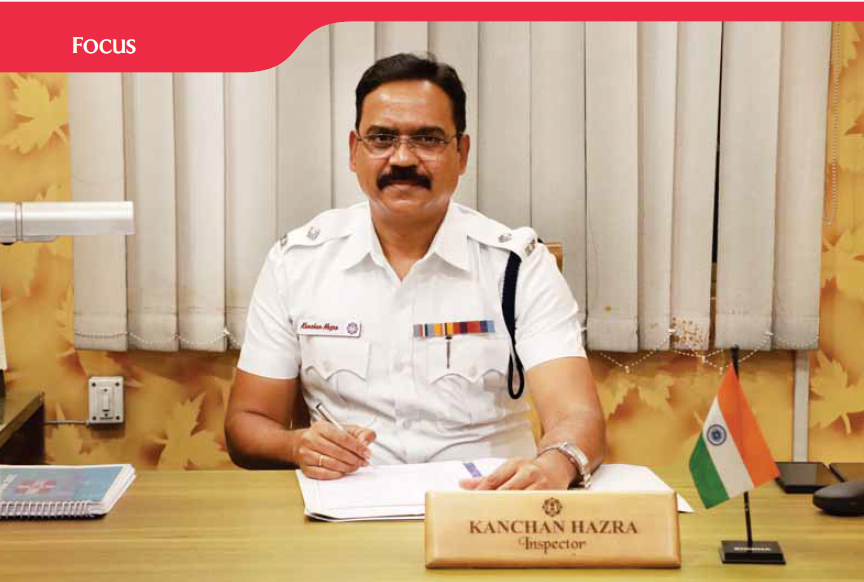
Headquarter Traffic Guard: The Nerve Centre of Kolkata’s Mobility
Team PROTECTOR
The Headquarter Traffic Guard is one of the most pivotal units under the jurisdiction of the Kolkata Traffic Police, ensuring smooth vehicular movement and time-sensitive assistance in the heart of the city. It covers a total area of approximately 4.62 square km. This unit plays a crucial role in managing the intricate traffic dynamics of Central Kolkata, an area that witnesses heavy footfall due to its administrative, commercial, and historical significance.
The Headquarter Traffic Guard oversees some of Kolkata’s most iconic heritage landmarks, many of which date back to the colonial era, and continues to serve as vital administrative and financial hubs. Notable structures within its jurisdiction include Raj Bhavan – the official residence of the Governor of West Bengal, a heritage structure from the British era; Writers’ Building – the historic Secretariat building of the State Government which is presently undergoing renovation; Calcutta High Court – one of the oldest High Courts in India, established in 1862; Kolkata Police Headquarters (Lalbazar) – the nerve centre of law enforcement in the city; Calcutta Stock Exchange – a crucial financial institution; Reserve Bank of India (RBI), Kolkata Branch – a key institution governing monetary policies in the region, and numerous banks and financial institutions.
Apart from its administrative importance, this area is home to some of Kolkata’s largest and oldest commercial districts. Key business zones include Canning Street (Biplabi Rashbehari Bose Road) – a major hub for wholesale trade, dealing in textiles, electronics, and household goods; Rabindra Sarani – famous for its bustling markets, particularly in metalware, chemicals, and traditional Bengali goods; the renowned electronics and hardware market – Chandni Chowk, plus several other wholesale markets that supply goods across the State and to a large portion of Eastern India.
A Legacy of Traffic Management in Kolkata
The Headquarter Traffic Guard is the oldest traffic guard under the jurisdiction of the Kolkata Traffic Police. Its rich history dates back to the mid-20th century, and it continues to be the cornerstone of Kolkata’s traffic enforcement.
Historical Evolution
Police archival records show that the Headquarter Traffic Guard has been operational since 1953. However, its roots trace even further back, as the building that houses it was originally known as Lalkin Guard. This facility served as a barrack and mess for Constables of the erstwhile Calcutta Police. The term “Lalkin” is believed to be derived from “Lal Dighi”, also called the Tank Square or Dalhousie Square, the historic man-made water tank in the heart of the city.
During 1952-1953, Sergeant R.D. Pandey was assigned as the Officer-in-Charge (O.C.) of the Traffic Guard.
In 1958, Inspector Narsdon Oliver Knight became the first Officer-in-Charge of this Traffic Guard, holding the rank of Inspector of Police.
Growth of the Kolkata Traffic Police
Between 1960 and 1970, Kolkata Traffic Police had six traffic guards, namely, Headquarter Traffic Guard, Jorabagan Traffic Guard, Shyambazar Traffic Guard, South Traffic Guard, East Traffic Guard, and South-West Traffic Guard.
Infrastructure and Location
The Headquarter Traffic Guard operates from 32/A, Brabourne Road, Kolkata – 700001. Before 1951, the building was a single-story structure. As per details, in 1952-1953, the building was requisitioned and hired by the Calcutta Police, marking its official integration into the city’s law enforcement framework. In 2019, a major renovation of the building commenced to upgrade its facilities.
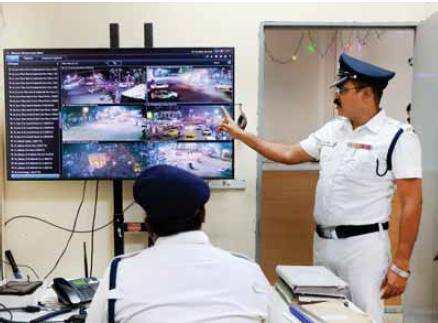
Operational Expansion
To enhance its operational efficiency, the Headquarter Traffic Guard expanded its presence.
In 2005, an outpost was established at Sidhu Kanu Dahar, equipped with modern technological facilities. This outpost functions as a satellite unit of the main office on Biplabi Maharaj Sarani, further strengthening traffic enforcement in Central Kolkata.
Officer-in-Charge, Headquarter Traffic Guard, Kanchan Hazra: A Journey of Dedication and Service
Born and raised in Niyamatpur, near Kulti in present-day Paschim Bardhaman, OC Kanchan Hazra is a testament to unwavering dedication and commitment to service. His journey into law enforcement is a story of single-minded focus and perseverance.
“I always wanted to join the Force. In fact, I never appeared for any other competitive examination in my life. After my Higher Secondary examination, I first applied for a job in the Indian Air Force. Later, I responded to an advertisement for multiple vacancies in the Central Police Organisation (CPO).
I completed my graduation from Asansol College and, in 1995, appeared for the post of Sergeant. That decision changed my life forever. Now, as I approach 30 years in service, I take immense pride in my profession every single day.”
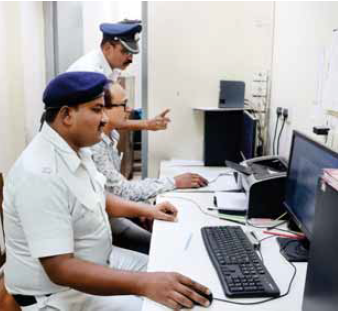
A Career Spanning Nearly Three Decades
Kanchan Hazra’s career trajectory reflects a wealth of experience across different divisions of the Kolkata Police. He began his career in the Reserve Force, where he served for a brief period before moving into active traffic management. His first major assignment in the Traffic Department – South West Traffic Guard – where he worked for six years, provided him with hands-on experience in managing one of Kolkata’s busiest traffic corridors. This was followed by an eight-year stint at Wireless Control. It was one of the most defining phases of his career. He says: “Although I have spent most of my career in the Traffic Department, my experience with Wireless Control remains strongly etched in my memory. Back then, alongside the Traffic Police, the Wireless Department functioned as a first responder. There was a fully operational wireless wing, which has now been diversified for better management.”
The Nabanna Transition
With the establishment of Nabanna as the administrative headquarters of the West Bengal government, a significant shift in governance infrastructure took place. This transition necessitated the creation of a new outpost to manage traffic and security in the area, ensuring smooth movement for government officials, ministers, and other dignitaries.
Kanchan Hazra was entrusted with overseeing the new outpost’s operations. He stated, “It was indeed a challenging task for our team. First and foremost, Nabanna was traditionally outside the jurisdiction of the Kolkata Police, so the entire adjustment required careful planning and execution. Additionally, with the administrative shift, all ministers, representatives, and high-ranking officials had to travel to Nabanna regularly. Given the importance and challenges of this transition, we worked as a strong, coordinated team and succeeded in our efforts.”
A Legacy of Leadership in Kolkata’s Traffic Management
While managing the Mandirtala Outpost, Kanchan Hazra carried an additional responsibility-serving as the Additional Officer-in-Charge (OC) of the Vidyasagar Traffic Guard. His ability to multitask and efficiently handle high-pressure situations made him a key figure in Kolkata’s traffic policing framework.
In 2016, Kanchan Hazra was appointed as the Officer-in-Charge (OC) of the Jadavpur Traffic Guard where his leadership brought about significant infrastructural and operational improvements. The Jadavpur Traffic Guard received a complete makeover with the construction of a new building adjacent to the Jadavpur Police Station. One of his biggest challenges was regulating vehicular movement in and around South City Mall, one of South Kolkata’s busiest commercial hubs. His strategic planning helped ease congestion and improve commuter safety. He also played a pivotal role in the construction of the subway near the Jadavpur 8B Bus Stand, which provided safer pedestrian movement. He was also instrumental in ensuring that the approach road to Gariahat Road was widened and improved thereby reducing bottlenecks in the high-traffic corridor.
In 2022, after years of impactful service across various divisions, Kanchan Hazra was transferred to the Headquarter Traffic Guard where he became its Officer-in-Charge. Sharing his thoughts about his latest posting, Hazra says: “Considering the jurisdiction of our Traffic Guard, we work around the clock to ensure smooth passage of vehicles. The high-density population, narrow lanes, and increasing vehicular traffic do not make the task easy. We believe in a modern, scientific approach to traffic policing where the comfort of pedestrians and commuters is not compromised. At the same time, road safety and security remain our top priority.”
Commitment to Emergency Response
Throughout his distinguished career in the Kolkata Traffic Police, Kanchan Hazra has witnessed and responded to numerous critical incidents, often taking direct action in rescue operations. His proactive approach and quick thinking have saved lives in high-pressure situations.
“My colleagues are aware that I always keep a crowbar and a chopper in my car for rescue purposes,” he shares, underscoring his readiness for emergencies. One such dramatic rescue occurred during his tenure at the Mandirtala Outpost where a Tata Ace (Chota Hathi) was involved in a severe collision, leaving the driver trapped as the steering column had wedged tightly against him. Time was running out for the fire brigade to arrive and extricate him safely. A quick-thinking Kanchan Hazra used his crowbar to bend the steering, successfully freeing the driver and ensuring his survival.
In another recent incident, his prompt action saved a driver who had fallen unconscious inside a locked vehicle. Hazra used his crowbar and chopper to break the glass, enabling a rapid rescue. The driver was swiftly rushed to the hospital, receiving timely medical attention.
A Midnight Rescue
In another incident, a few years ago, on a stormy night, Kanchan Hazra was returning home in his Tata Sumo when torrential rain lashed the city. Just as he approached the Majherhat Flyover, he noticed a car with its backlight on, motionless in the downpour. Something felt off. His instinct told him to stop. Drenched in rain, he approached the vehicle and found a man in the driver’s seat, visibly distressed. His car had broken down, and inside were his wife, children, and elderly parents—stranded in the middle of the night with no way to get home. Without hesitation, Hazra arranged for a breakdown van and offered the stranded family his vehicle, ensuring they reached their home safely in Sarsuna. Though he reached home way past 1:00 a.m., he did not feel inconvenienced but felt a deep sense of satisfaction. He says, “The police uniform gives us such opportunities to stand by citizens in their hour of need.”
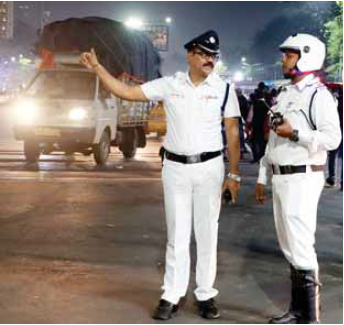
Navigating Agitation and Stress in Law Enforcement
In an era where patience and perseverance are crucial for handling high-pressure situations, the aftermath of the RG Kar incident proved to be a litmus test of the resilience of the Head Quarter Traffic Guard personnel. Hazra recalled, “Believe me, it wasn’t easy. We faced numerous situations where processions and protests occurred simultaneously, requiring our constant vigilance. In one incident, we found ourselves surrounded by a group of agitated individuals who were angry about the traffic jam. We relied on patience, maintained our composure, and worked to de-escalate the situation. Years of experience have taught me that keeping a cool head is often the best solution.”
There is immense mental strain that comes with police work. Hazra strongly advocates for a simple and balanced approach to stress management. “Managing stress is an essential skill that every officer must develop to thrive in this profession. It is crucial to maintain a structured lifestyle, balanced diet, and good physical fitness. On days when I am not on morning shifts, I make it a priority to jog and perform physical drills in the Maidan area. A healthy lifestyle is important for everyone, but it is especially vital for those in uniform; it is a necessity.”
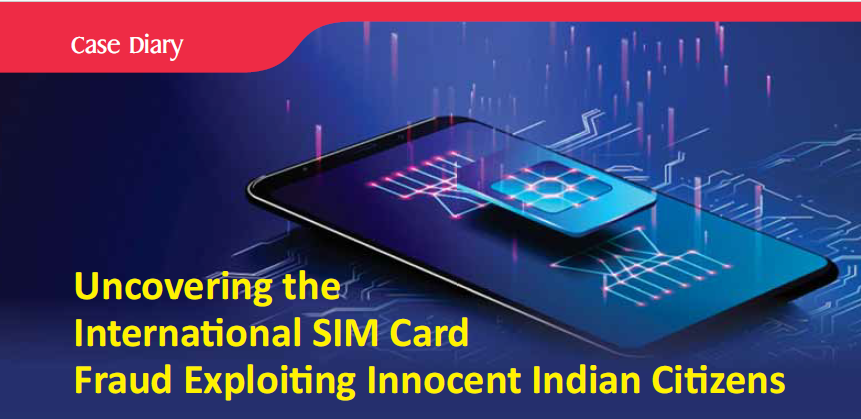
Uncovering the International SIM Card Fraud Exploiting Innocent Indian Citizens
The development and use of SIM (Subscriber Identity Module) cards are closely tied to the evolution of mobile telecommunications technology. Mobile phones began in the 1940s with vehicle-based systems. The first handheld call was made in 1973 by Motorola, and the first commercial phone was launched in 1983. SIM cards were developed alongside the growth of mobile telecommunications. In the 1970s and 1980s, mobile phones were analogue and tied to specific networks, with no way to transfer user information. In 1982, the GSM (Global System for Mobile Communications) project was launched to standardise mobile communication, focusing on security and portability. By 1991, GSM introduced SIM cards as a removable module to store subscriber details like phone numbers and network credentials. This revolutionised communication, making mobile phones compact, affordable, and essential for modern life. Today, SIM cards are central to mobile communications, enabling secure connections to networks worldwide.Since the advent of mobile phones, SIM cards have become an essential part of the telecom industry. In today’s rapidly digitising world, unauthorised SIM cards have emerged as tools for cybercrime, endangering innocent individuals. A recent case involving the Kolkata Police has shed light on this issue and served as a wake-up call for security agencies nationwide.
In April 2024, the Customs Department intercepted a shipment booked with DHL courier for Phnom Penh, Cambodia. They discovered 361 pre-activated Airtel SIM cards concealed in the lids of two filter coffee bottles. Following this, the Intelligence Bureau in Kolkata collected additional information and investigated the matter. It was revealed that the consignment was booked by an individual residing in Kolkata.
Further investigation uncovered similar shipments were made on previous occasions. Of the 361 SIM cards, 243 were issued under the jurisdiction of the Kolkata Police. Additionally, it was established that these 243 Airtel SIM cards were registered under the names of various people across West Bengal, with the issuing agents located in the Topsia, Tiljala, Ultadanga, Kasba, and Ashoknagar areas.
Mode of Operation (Modus Operandi)
A notice under Section 179 of the BNSS has been served to individuals against whom SIM cards were issued. According to their accounts, when they visited the agent to obtain a new SIM card in their name, they were asked to provide their fingerprint using a morpho machine multiple times. When an individual inquired the reason for this, the agent explained that the SIM card could not be processed initially due to network issues.
The agent took multiple SIM cards in the names of unsuspecting individuals and attempted to send these SIM cards to Cambodia with the help of their associates to commit offences.
Investigation Details
Based on the collected documents and recorded statements, fake, fictitious SIM cards were created using electronic methods. These fake SIM cards were later used as genuine ones and sent to foreign countries like Cambodia. There, they were used to carry out fraud, including investment scams and other crimes. This case involves electronic forgery, leading to cheating and victimising innocent people.
Kolkata Police officials from the Anti-Bank Fraud Section of the Detective Department seized electronic devices, mobile phones, and blank SIM card pouches from the arrested accused. The entire operation seems to have been coordinated, involving individuals connected with POS agencies, employees of Airtel distributors, and foreign nationals.
A Myanmar national was arrested in a hotel in Hyderabad, where police seized numerous incriminating documents, cash in various currencies, mobile phones, laptops, foreign SIM cards, and pen drives. The identities of the accused’s associates who were present in Kolkata at the time of the offence were also uncovered through a detailed investigation. Information was found regarding fraudulent investments linked to one of the companies owned by a foreign national. Notably, one of the accused exchanged cryptocurrency with a foreign national, returning the cash equivalent two months later.
The Anti-Bank Fraud Unit of the Detective Department of Kolkata Police has made significant progress in investigating an international SIM card fraud. This operation involved exporting
pre-activated SIM cards in the names of unsuspecting individuals, concealed in coffee containers, to commit criminal offences and electronic forgery.
Source:
Anti-Bank Fraud Section, Detective Department, Kolkata Police.